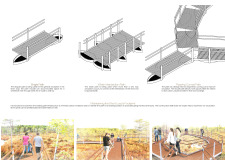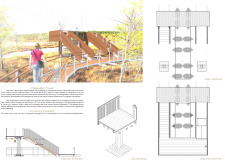5 key facts about this project
The design emphasizes inclusivity, featuring wheelchair-accessible pathways that allow all visitors to explore the varied terrains of the park effortlessly. The spatial organization of the pathways includes curves and wider intersections, promoting a slower pace of exploration that fosters a deeper connection with the natural surroundings.
The observation tower serves as a key focal point within the project. Elevated above the landscape, it provides panoramic views of the expansive wetlands and surrounding forests. The choice of materials, including reclaimed wood and glass, integrates the structure with its environment while offering a level of transparency and visual connection with the surroundings.
The unique approach of the project lies in its consideration of environmental impact and user experience. The implementation of a floating footbridge, inspired by snowshoe design, minimizes contact with the ground, thereby preserving the sensitive ecosystems of the wetlands. This design detail reflects a commitment to maintaining ecological integrity while enhancing accessibility.
The integration of reclaimed materials not only reduces environmental waste but also allows the structure to blend seamlessly with the park's natural features. The use of dimensional lumber for structural elements, together with metal mesh for stability, further exemplifies the project's sustainable practices.
The architectural plans and sections detail the careful consideration given to site topography and natural features, revealing how each element was designed to coexist with the local environment. Visitors are encouraged to explore the architectural designs and ideas further, offering insights into the thoughtful planning that defines this project. For a comprehensive understanding of the overall design and its components, it is advisable to review the project presentation to appreciate its various aspects fully.


























